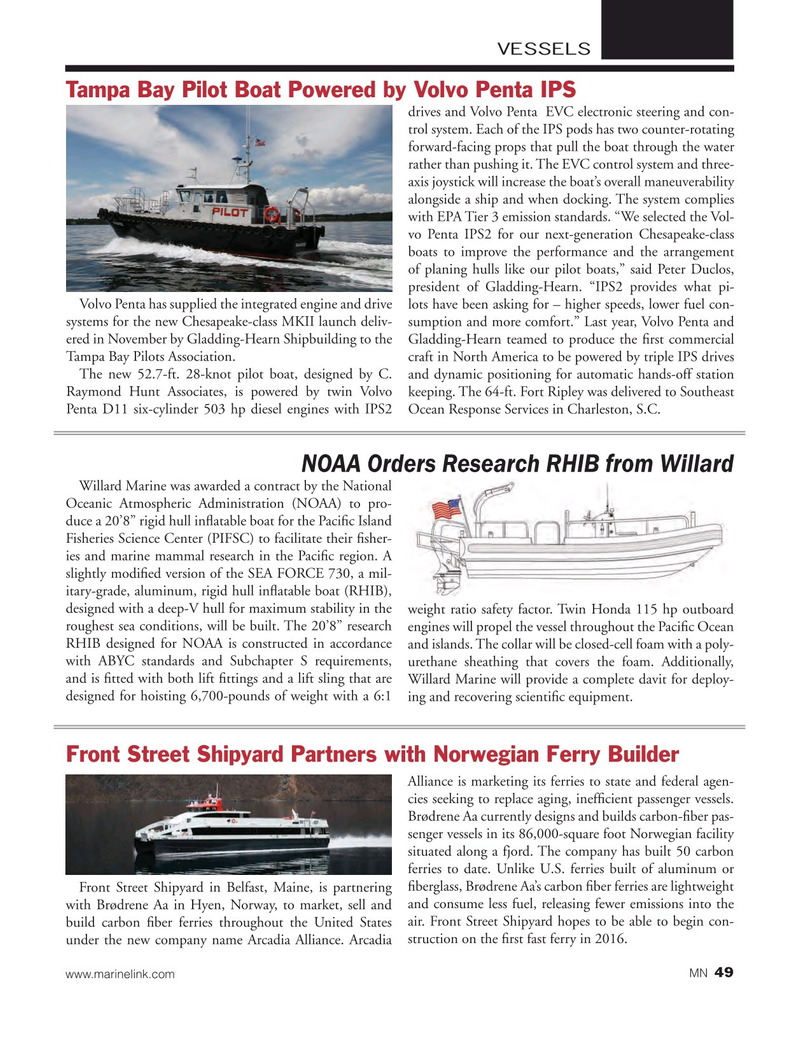
Page 49: of Marine News Magazine (January 2016)
Read this page in Pdf, Flash or Html5 edition of January 2016 Marine News Magazine
VESSELS
Tampa Bay Pilot Boat Powered by Volvo Penta IPS drives and Volvo Penta EVC electronic steering and con- trol system. Each of the IPS pods has two counter-rotating forward-facing props that pull the boat through the water rather than pushing it. The EVC control system and three- axis joystick will increase the boat’s overall maneuverability alongside a ship and when docking. The system complies with EPA Tier 3 emission standards. “We selected the Vol- vo Penta IPS2 for our next-generation Chesapeake-class boats to improve the performance and the arrangement of planing hulls like our pilot boats,” said Peter Duclos, president of Gladding-Hearn. “IPS2 provides what pi-
Volvo Penta has supplied the integrated engine and drive lots have been asking for – higher speeds, lower fuel con- systems for the new Chesapeake-class MKII launch deliv- sumption and more comfort.” Last year, Volvo Penta and ered in November by Gladding-Hearn Shipbuilding to the Gladding-Hearn teamed to produce the ? rst commercial
Tampa Bay Pilots Association. craft in North America to be powered by triple IPS drives
The new 52.7-ft. 28-knot pilot boat, designed by C. and dynamic positioning for automatic hands-off station
Raymond Hunt Associates, is powered by twin Volvo keeping. The 64-ft. Fort Ripley was delivered to Southeast
Penta D11 six-cylinder 503 hp diesel engines with IPS2 Ocean Response Services in Charleston, S.C.
NOAA Orders Research RHIB from Willard
Willard Marine was awarded a contract by the National
Oceanic Atmospheric Administration (NOAA) to pro- duce a 20’8” rigid hull in? atable boat for the Paci? c Island
Fisheries Science Center (PIFSC) to facilitate their ? sher- ies and marine mammal research in the Paci? c region. A slightly modi? ed version of the SEA FORCE 730, a mil- itary-grade, aluminum, rigid hull in? atable boat (RHIB), designed with a deep-V hull for maximum stability in the weight ratio safety factor. Twin Honda 115 hp outboard roughest sea conditions, will be built. The 20’8” research engines will propel the vessel throughout the Paci? c Ocean
RHIB designed for NOAA is constructed in accordance and islands. The collar will be closed-cell foam with a poly- with ABYC standards and Subchapter S requirements, urethane sheathing that covers the foam. Additionally, and is ? tted with both lift ? ttings and a lift sling that are Willard Marine will provide a complete davit for deploy- designed for hoisting 6,700-pounds of weight with a 6:1 ing and recovering scienti? c equipment.
Front Street Shipyard Partners with Norwegian Ferry Builder
Alliance is marketing its ferries to state and federal agen- cies seeking to replace aging, inef? cient passenger vessels.
Brødrene Aa currently designs and builds carbon-? ber pas- senger vessels in its 86,000-square foot Norwegian facility situated along a fjord. The company has built 50 carbon ferries to date. Unlike U.S. ferries built of aluminum or
Front Street Shipyard in Belfast, Maine, is partnering ? berglass, Brødrene Aa’s carbon ? ber ferries are lightweight with Brødrene Aa in Hyen, Norway, to market, sell and and consume less fuel, releasing fewer emissions into the build carbon ? ber ferries throughout the United States air. Front Street Shipyard hopes to be able to begin con- under the new company name Arcadia Alliance. Arcadia struction on the ? rst fast ferry in 2016. 49 www.marinelink.com MN
MN Jan16 Layout 32-49.indd 49 1/6/2016 2:42:43 PM

 48
48

 50
50
